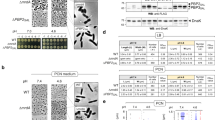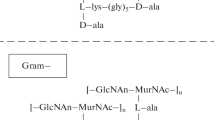Abstract
When grown in a complex peptone-yeast extract culture medium, Seliberia stellata and related morphologically similar aquatic bacterial strains typically divided asymmetrically, giving rise to a motile swarmer and a longer sessile rod. Indirect immunoferritin labeling of these bacteria, followed by incubation during which cell growth occurred, has provided evidence that antigenic cell-surface components are synthesized de novo in a sharply demarcated zone at one pole of the growing parent cells. Cell elongation occurred unidirectionally from the pole showing the de novo surface synthesis; it was this end of the elongating, helically sculptured (i.e., screw-like) rod that became the daughter swarmer cell. The daughter swarmers, produced after polar growth and division of the immunoferritinlabeled parent cells, were not labeled. The immunoferritin label remaining on the parent cell did not appear to be diluted or disturbed by the cell growth and division process. Under the cultural conditions used in this study, the growth and division events which led to production of swarmer cells in the seliberia strains examined met two major criteria of accepted definitions of budding (de novo cell surface synthesis and transverse asymmetry of division). However, the developing daughter cell was not initially narrower than the parent and thus did not increase in cell diameter during growth.
Similar content being viewed by others
References
Aristovskaya TV (1958) The decomposition of fulvic acids by micro-organisms. Soviet Soil Science [English translation of Pochvovedeniye] no 11: 1224–1233
Aristovskaya TV (1964) The taxonomic position of the genus Seliberia Arist. et Parink. Microbiology [English translation of Mikrobiologiya] 33:823–828
Aristovskaya TV (1974) Seliberia. In: Buchanan RE, Gibbons NE (eds) Bergey's manual of determinative bacteriology, 8th edn. Williams and Wilkins, Baltimore, p 160
Aristovskaya TV, Parinkina VV (1961) New methods of studying soil microorganism associations. Soviet Soil Science [English translation of Pochvovedeniye] no 1:12–20
Aristovskaya TV, Parinkina VV (1963) New soil microorganism Seliberia stellata nov. gen. n. sp. Izv Akad Nauk SSSR Ser Biol 28 (1):49–56
Brock TD (1979) Biology of microorganisms. Prentice-Hall, Inc., Englewood Cliffs, New Jersey, pp 644–645
Bruning JL, Kintz BL (1968) Computational handbook of statistics. Scott, Foresman and Company, Glenview, Ill., pp 4–15
Buchanan RE, Gibbons NE (eds) (1974) Part IV. Budding and/or appendaged bacteria. In Bergey's manual of determinative bacteriology, 8th edn. Williams and Wilkins, Baltimore, pp 148–166
Burdett IDJ, Murray RGE (1974) Septum formation in Escherichia coli: Characterization of septal structure and the effect of antibiotics on cell division. J Bacteriol 119:303–324
Cohen-Bazire G, Sistrom WR, Stanier RY (1957) Kinetic studies of pigment synthesis by non-sulfur purple bacteria. J Cell Comp Physiol 49:25–68
Hirsch P (1974) Budding bacteria. Ann Rev Microbiol 28:391–444
Lowry OH, Rosebrough NJ, Farr AL, Randall RJ (1951) Protein measurement with the Folin phenol reagent. J Biol Chem 193:265–275
Meyer O, Lalucat J, Schlegel HG (1980) Pseudomonas carboxydohydrogena (Sanjieva and Zavarzin) comb. nov., a monotrichous, nonbudding, strictly aerobic, carbon monoxide-utilizing hydrogen bacterium previously assigned to Seliberia. Int J Syst Bacteriol 30:189–195
Pfennig N (1969) Rhodopseudomonas acidophila, sp. n., a new species of the budding purple nonsulfur bacteria. J Bacteriol 99:597–602
Poindexter JS (1964) Biological properties and classification of the Caulobacter group. Bacteriol Rev 28:231–295
Poindexter JS (1981) The Caulobacters: Ubiquitous unusual bacteria. Microbiol Rev 45:123–179
Reed WM, Dugan PR (1979) Study of developmental stages of Methylosinus trichosporium with the aid of fluorescent-antibody staining techniques. Appl Environ Microbiol 38:1179–1183
Sanzhieva EU, Zavarzin GA (1971) A bacterium which oxidizes carbon monoxide. [English translation] Dokl Akad Nauk SSSR 196:956–958
Schmidt JM (1978) Isolation and ultrastructure of freshwater strains of Planctomyces. Curr Microbiol. 1:65–70
Schmidt JM, Swafford JR (1979) Isolation and morphology of helically sculptured, rosette-forming, freshwater bacteria resembling Seliberia. Curr Microbiol 3:65–70
Schmidt JM, Swafford JR (1981) The genus Seliberia. In: Starr MP, Stolp H, Trüper HG, Balows A, Schlegel HG (eds) The prokaryotes: A handbook on habitats, isolation, and identification of bacteria. Springer, Berlin Heidelberg New York, pp 516–519
Smit J, Agabian N (1982) Cell surface patterning and morphogenesis: Biogenesis of a periodic surface array during Caulobacter development. J Cell Biol 95:41–49
Staley JT (1973) Budding and prosthecate bacteria In: Laskin AI, Lechevalier HA (eds) Organismic microbiology. Handbook of microbiology, vol 1, 1st edn. CRC Press, Cleveland, Ohio, pp 29–49
Staley JT, Hirsch P, Schmidt JM (1981) Introduction to the budding and/or appendaged bacteria. In: Starr MP, Stolp H, Trüper HG, Balows A, Schlegel HG (eds) The prokaryotes: A handbook on habitats, isolation, and identification of bacteria. Springer, Berlin Heidelberg New York, pp 451–455
Tekniepe BL, Schmidt JM, Starr MP (1982) Immunoferritin labeling shows de novo synthesis of surface components in buds of a prokaryote belonging to morphotype IV of the Blastocaulis-Planctomyces group. Curr Microbiol 7:1–6
Whittenbury R, McLee AG (1967) Rhodopseudomonas palustris and Rh. viridis — photosynthetic budding bacteria. Arch Mikrobiol 59:324–334
Author information
Authors and Affiliations
Additional information
In memory: R. Y. Stanier
Rights and permissions
About this article
Cite this article
Schmidt, J.M., Starr, M.P. Unidirectional polar growth of cells of Seliberia stellata and aquatic seliberia-like bacteria revealed by immunoferritin labeling. Arch. Microbiol. 138, 89–95 (1984). https://doi.org/10.1007/BF00413006
Received:
Accepted:
Issue Date:
DOI: https://doi.org/10.1007/BF00413006




